Management 3: Zara's Strategic Analysis and Recommendations Report
VerifiedAdded on 2022/11/26
|20
|4054
|175
Report
AI Summary
This report provides a comprehensive strategic analysis of Zara, a leading global fashion retailer. It begins with an executive summary and introduction, followed by an examination of Zara's mission and vision statements. The external analysis includes a competitive profile matrix and an assessment using Porter's Five Forces to understand the industry dynamics and competitive pressures. The internal analysis delves into Zara's value chain and financial ratios to evaluate its operational efficiency and financial performance. Based on these analyses, the report develops an organizational strategy, including an examination of Porter's generic strategies and Zara's existing business strategy. The report then proposes a strategic plan for Zara, offering specific suggestions for improvement and future sustainability, such as expanding distribution centers. The report concludes with references and an appendix for supporting information.
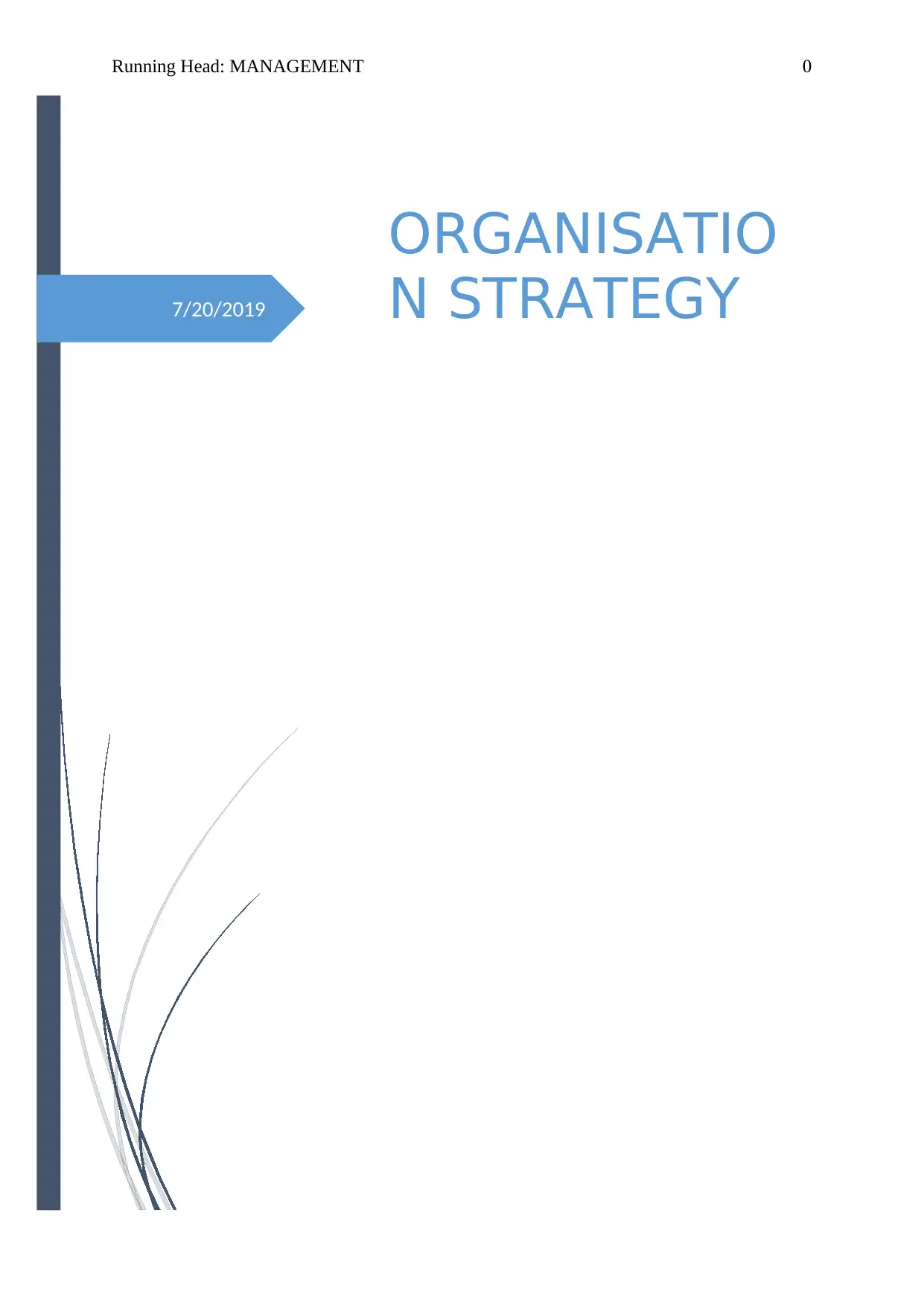
7/20/2019
Running Head: MANAGEMENT 0
ORGANISATIO
N STRATEGY
Running Head: MANAGEMENT 0
ORGANISATIO
N STRATEGY
Paraphrase This Document
Need a fresh take? Get an instant paraphrase of this document with our AI Paraphraser
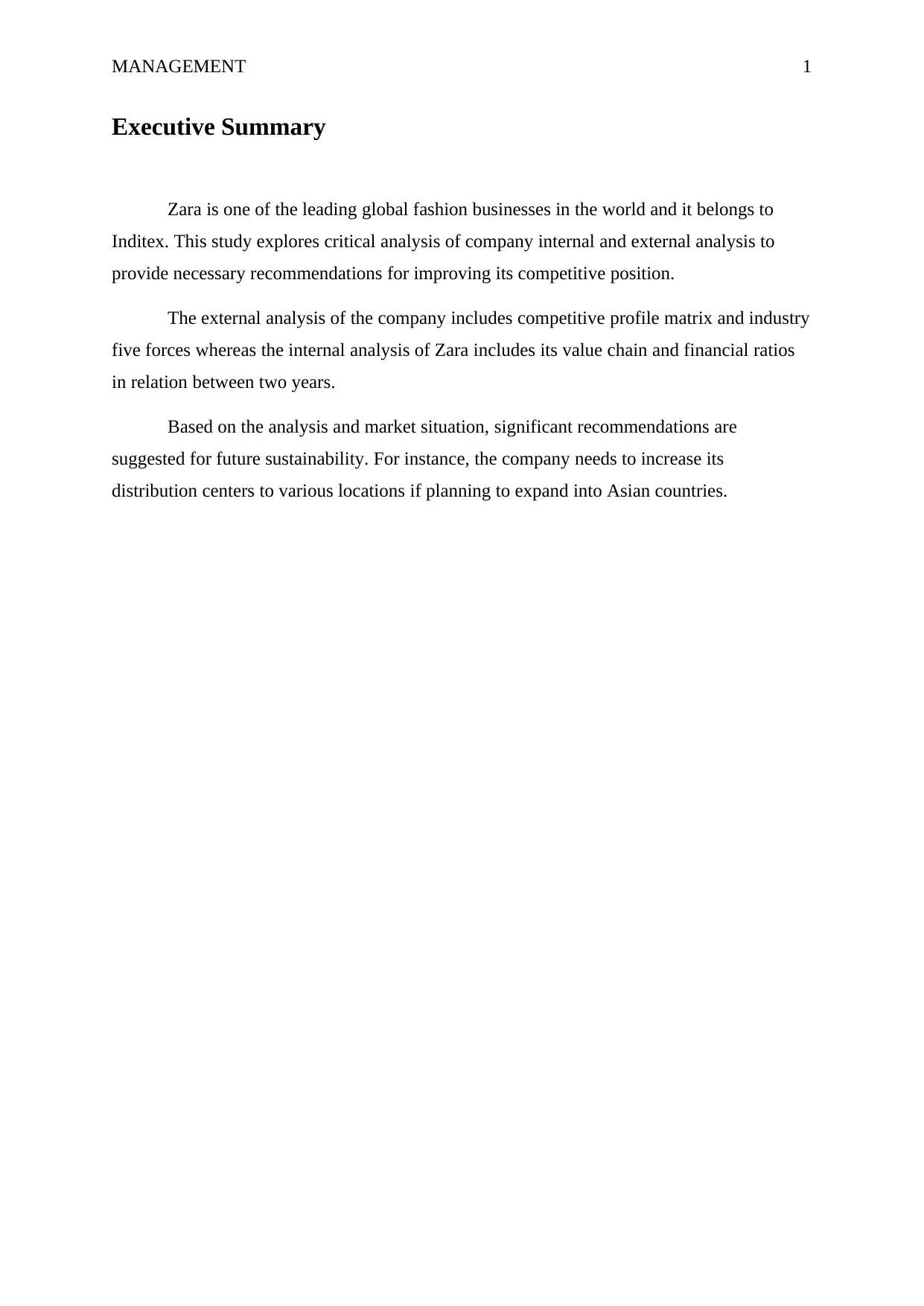
MANAGEMENT 1
Executive Summary
Zara is one of the leading global fashion businesses in the world and it belongs to
Inditex. This study explores critical analysis of company internal and external analysis to
provide necessary recommendations for improving its competitive position.
The external analysis of the company includes competitive profile matrix and industry
five forces whereas the internal analysis of Zara includes its value chain and financial ratios
in relation between two years.
Based on the analysis and market situation, significant recommendations are
suggested for future sustainability. For instance, the company needs to increase its
distribution centers to various locations if planning to expand into Asian countries.
Executive Summary
Zara is one of the leading global fashion businesses in the world and it belongs to
Inditex. This study explores critical analysis of company internal and external analysis to
provide necessary recommendations for improving its competitive position.
The external analysis of the company includes competitive profile matrix and industry
five forces whereas the internal analysis of Zara includes its value chain and financial ratios
in relation between two years.
Based on the analysis and market situation, significant recommendations are
suggested for future sustainability. For instance, the company needs to increase its
distribution centers to various locations if planning to expand into Asian countries.

MANAGEMENT 2
Contents
Introduction................................................................................................................................3
About Zara.............................................................................................................................3
Analysis of Mission and Vision.................................................................................................4
External Analysis.......................................................................................................................6
The Competitive Profile.........................................................................................................6
Porter 5 Forces.......................................................................................................................7
Internal Analysis........................................................................................................................9
Value Chain............................................................................................................................9
Financial Ratios....................................................................................................................10
Development of organizational strategy..................................................................................11
Porter Generic Strategy........................................................................................................11
Existing business strategy of Zara........................................................................................12
Strategic Plan for Zara.........................................................................................................12
Suggestions..............................................................................................................................13
References................................................................................................................................14
Appendix 1...............................................................................................................................16
Contents
Introduction................................................................................................................................3
About Zara.............................................................................................................................3
Analysis of Mission and Vision.................................................................................................4
External Analysis.......................................................................................................................6
The Competitive Profile.........................................................................................................6
Porter 5 Forces.......................................................................................................................7
Internal Analysis........................................................................................................................9
Value Chain............................................................................................................................9
Financial Ratios....................................................................................................................10
Development of organizational strategy..................................................................................11
Porter Generic Strategy........................................................................................................11
Existing business strategy of Zara........................................................................................12
Strategic Plan for Zara.........................................................................................................12
Suggestions..............................................................................................................................13
References................................................................................................................................14
Appendix 1...............................................................................................................................16
⊘ This is a preview!⊘
Do you want full access?
Subscribe today to unlock all pages.

Trusted by 1+ million students worldwide
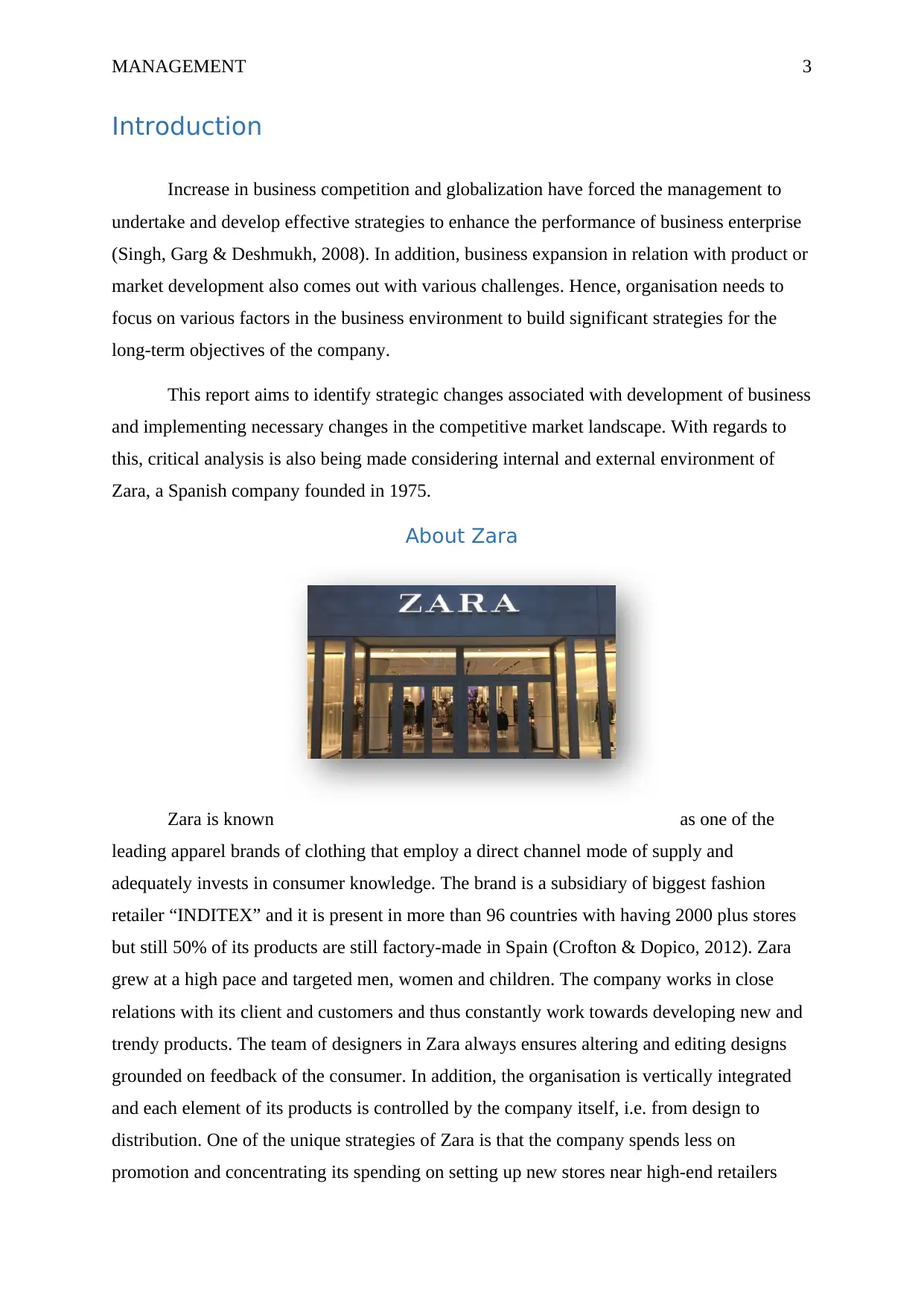
MANAGEMENT 3
Introduction
Increase in business competition and globalization have forced the management to
undertake and develop effective strategies to enhance the performance of business enterprise
(Singh, Garg & Deshmukh, 2008). In addition, business expansion in relation with product or
market development also comes out with various challenges. Hence, organisation needs to
focus on various factors in the business environment to build significant strategies for the
long-term objectives of the company.
This report aims to identify strategic changes associated with development of business
and implementing necessary changes in the competitive market landscape. With regards to
this, critical analysis is also being made considering internal and external environment of
Zara, a Spanish company founded in 1975.
About Zara
Zara is known as one of the
leading apparel brands of clothing that employ a direct channel mode of supply and
adequately invests in consumer knowledge. The brand is a subsidiary of biggest fashion
retailer “INDITEX” and it is present in more than 96 countries with having 2000 plus stores
but still 50% of its products are still factory-made in Spain (Crofton & Dopico, 2012). Zara
grew at a high pace and targeted men, women and children. The company works in close
relations with its client and customers and thus constantly work towards developing new and
trendy products. The team of designers in Zara always ensures altering and editing designs
grounded on feedback of the consumer. In addition, the organisation is vertically integrated
and each element of its products is controlled by the company itself, i.e. from design to
distribution. One of the unique strategies of Zara is that the company spends less on
promotion and concentrating its spending on setting up new stores near high-end retailers
Introduction
Increase in business competition and globalization have forced the management to
undertake and develop effective strategies to enhance the performance of business enterprise
(Singh, Garg & Deshmukh, 2008). In addition, business expansion in relation with product or
market development also comes out with various challenges. Hence, organisation needs to
focus on various factors in the business environment to build significant strategies for the
long-term objectives of the company.
This report aims to identify strategic changes associated with development of business
and implementing necessary changes in the competitive market landscape. With regards to
this, critical analysis is also being made considering internal and external environment of
Zara, a Spanish company founded in 1975.
About Zara
Zara is known as one of the
leading apparel brands of clothing that employ a direct channel mode of supply and
adequately invests in consumer knowledge. The brand is a subsidiary of biggest fashion
retailer “INDITEX” and it is present in more than 96 countries with having 2000 plus stores
but still 50% of its products are still factory-made in Spain (Crofton & Dopico, 2012). Zara
grew at a high pace and targeted men, women and children. The company works in close
relations with its client and customers and thus constantly work towards developing new and
trendy products. The team of designers in Zara always ensures altering and editing designs
grounded on feedback of the consumer. In addition, the organisation is vertically integrated
and each element of its products is controlled by the company itself, i.e. from design to
distribution. One of the unique strategies of Zara is that the company spends less on
promotion and concentrating its spending on setting up new stores near high-end retailers
Paraphrase This Document
Need a fresh take? Get an instant paraphrase of this document with our AI Paraphraser
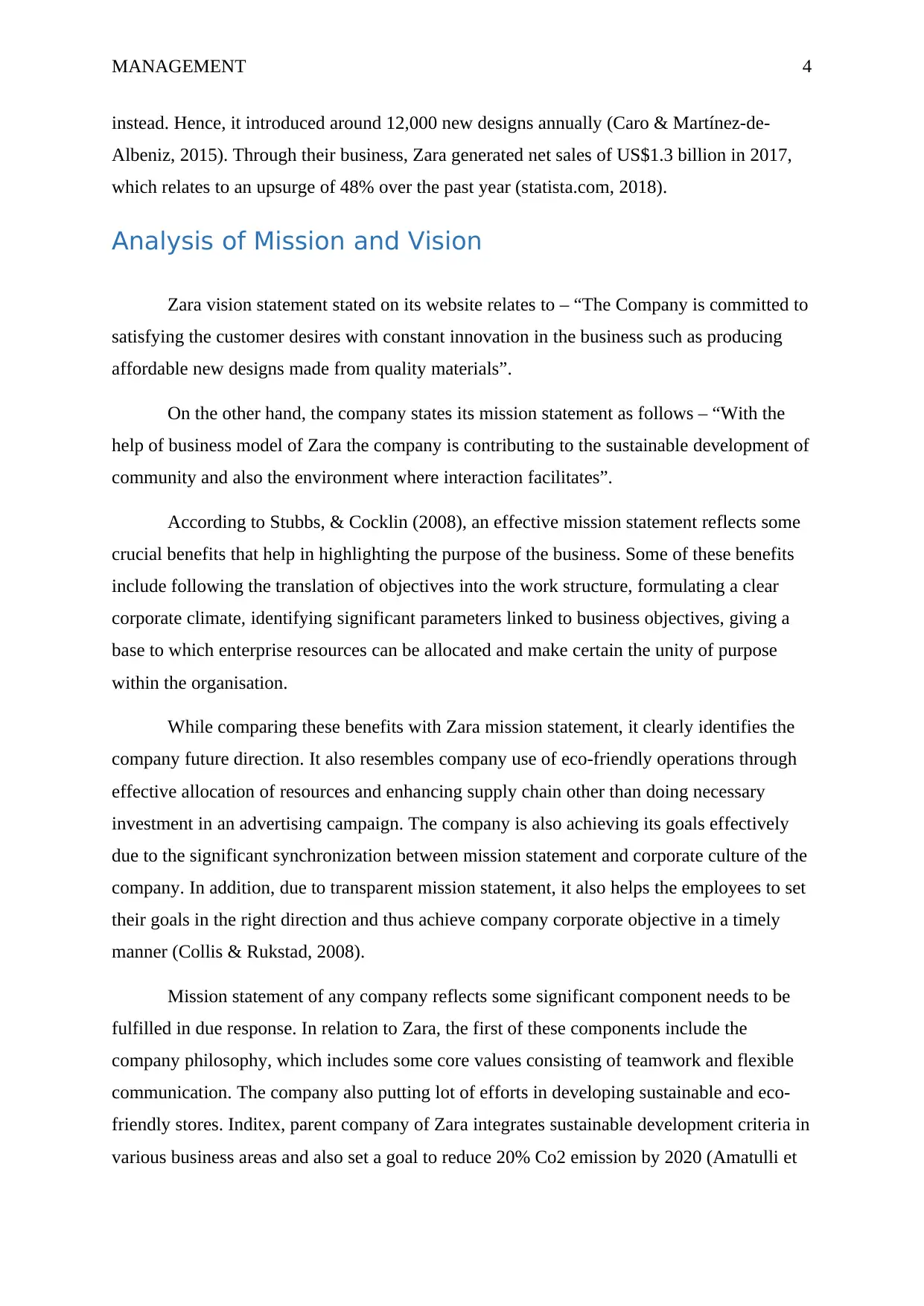
MANAGEMENT 4
instead. Hence, it introduced around 12,000 new designs annually (Caro & Martínez-de-
Albeniz, 2015). Through their business, Zara generated net sales of US$1.3 billion in 2017,
which relates to an upsurge of 48% over the past year (statista.com, 2018).
Analysis of Mission and Vision
Zara vision statement stated on its website relates to – “The Company is committed to
satisfying the customer desires with constant innovation in the business such as producing
affordable new designs made from quality materials”.
On the other hand, the company states its mission statement as follows – “With the
help of business model of Zara the company is contributing to the sustainable development of
community and also the environment where interaction facilitates”.
According to Stubbs, & Cocklin (2008), an effective mission statement reflects some
crucial benefits that help in highlighting the purpose of the business. Some of these benefits
include following the translation of objectives into the work structure, formulating a clear
corporate climate, identifying significant parameters linked to business objectives, giving a
base to which enterprise resources can be allocated and make certain the unity of purpose
within the organisation.
While comparing these benefits with Zara mission statement, it clearly identifies the
company future direction. It also resembles company use of eco-friendly operations through
effective allocation of resources and enhancing supply chain other than doing necessary
investment in an advertising campaign. The company is also achieving its goals effectively
due to the significant synchronization between mission statement and corporate culture of the
company. In addition, due to transparent mission statement, it also helps the employees to set
their goals in the right direction and thus achieve company corporate objective in a timely
manner (Collis & Rukstad, 2008).
Mission statement of any company reflects some significant component needs to be
fulfilled in due response. In relation to Zara, the first of these components include the
company philosophy, which includes some core values consisting of teamwork and flexible
communication. The company also putting lot of efforts in developing sustainable and eco-
friendly stores. Inditex, parent company of Zara integrates sustainable development criteria in
various business areas and also set a goal to reduce 20% Co2 emission by 2020 (Amatulli et
instead. Hence, it introduced around 12,000 new designs annually (Caro & Martínez-de-
Albeniz, 2015). Through their business, Zara generated net sales of US$1.3 billion in 2017,
which relates to an upsurge of 48% over the past year (statista.com, 2018).
Analysis of Mission and Vision
Zara vision statement stated on its website relates to – “The Company is committed to
satisfying the customer desires with constant innovation in the business such as producing
affordable new designs made from quality materials”.
On the other hand, the company states its mission statement as follows – “With the
help of business model of Zara the company is contributing to the sustainable development of
community and also the environment where interaction facilitates”.
According to Stubbs, & Cocklin (2008), an effective mission statement reflects some
crucial benefits that help in highlighting the purpose of the business. Some of these benefits
include following the translation of objectives into the work structure, formulating a clear
corporate climate, identifying significant parameters linked to business objectives, giving a
base to which enterprise resources can be allocated and make certain the unity of purpose
within the organisation.
While comparing these benefits with Zara mission statement, it clearly identifies the
company future direction. It also resembles company use of eco-friendly operations through
effective allocation of resources and enhancing supply chain other than doing necessary
investment in an advertising campaign. The company is also achieving its goals effectively
due to the significant synchronization between mission statement and corporate culture of the
company. In addition, due to transparent mission statement, it also helps the employees to set
their goals in the right direction and thus achieve company corporate objective in a timely
manner (Collis & Rukstad, 2008).
Mission statement of any company reflects some significant component needs to be
fulfilled in due response. In relation to Zara, the first of these components include the
company philosophy, which includes some core values consisting of teamwork and flexible
communication. The company also putting lot of efforts in developing sustainable and eco-
friendly stores. Inditex, parent company of Zara integrates sustainable development criteria in
various business areas and also set a goal to reduce 20% Co2 emission by 2020 (Amatulli et

MANAGEMENT 5
al, 2017). The second component is related with Zara products and customers, which includes
clothing accessories, bedding, and home set collections created for all men, women and kids
who seek for tending fashion in the respective culture. The next component is technology
where the company have adopted Hybrid Model information technology allowing company
to improve its value chain and help in reducing manufacturing time. Self – concept is another
significant component offering Zara a competitive advantage. For instance, Zara comes up
with 12, 000 new designs per year and use distinct strategy such as setting up their attractive
stores at prime locations. One of the mission components is also linked to community relating
to showing concern for a public image where the company present and act like being an
environment friendly organisation.
Now, the question arises whether the company vision or mission statement is
achievable. The company is successfully serving the latest market trends all over the world
with having a big list of fans including all customers i.e. men, women and children’s
(Lindgren & Abdullah, 2013). While evaluating company vision, it can be stated that the
vision of the organisation is not achievable but actually achieved. In relation with the mission
of Zara, the company is successfully moving towards its future direction and goals with its
unique strategy and long-term goals. Hence, the company mission looks likely encouraging,
attainable and actually enduring. This is because of the company form of quick-response for
their consumers who wish for the latest trend of apparels.
al, 2017). The second component is related with Zara products and customers, which includes
clothing accessories, bedding, and home set collections created for all men, women and kids
who seek for tending fashion in the respective culture. The next component is technology
where the company have adopted Hybrid Model information technology allowing company
to improve its value chain and help in reducing manufacturing time. Self – concept is another
significant component offering Zara a competitive advantage. For instance, Zara comes up
with 12, 000 new designs per year and use distinct strategy such as setting up their attractive
stores at prime locations. One of the mission components is also linked to community relating
to showing concern for a public image where the company present and act like being an
environment friendly organisation.
Now, the question arises whether the company vision or mission statement is
achievable. The company is successfully serving the latest market trends all over the world
with having a big list of fans including all customers i.e. men, women and children’s
(Lindgren & Abdullah, 2013). While evaluating company vision, it can be stated that the
vision of the organisation is not achievable but actually achieved. In relation with the mission
of Zara, the company is successfully moving towards its future direction and goals with its
unique strategy and long-term goals. Hence, the company mission looks likely encouraging,
attainable and actually enduring. This is because of the company form of quick-response for
their consumers who wish for the latest trend of apparels.
⊘ This is a preview!⊘
Do you want full access?
Subscribe today to unlock all pages.

Trusted by 1+ million students worldwide

MANAGEMENT 6
External Analysis
The Competitive Profile
The Competitive Profile Matrix explores enterprise main rivals and its certain
strengths and weakness in association to Zara firm strategic place. The below matrix is
developed by taking two biggest competitors of Zara i.e. H&M and Uniqlo in extent with
critical success factors.
Critical Success
Factors Weight Zara Uniqlo H&M
Rating Score Rating Score Rating Score
Entry marketing
strategy 0.05 2 0.1 4 0.2 2 0.1
Entry Timings 0.05 2 0.1 4 0.2 2 0.1
Target foreign
marketplace
selection
0.15 4 0.6 2 0.3 3 0.45
Brand Recognition 0.12 4 0.48 3 0.36 3 0.36
Provision of marketing
in international
marketplace
0.06 1 0.06 4 0.24 4 0.24
Location selection 0.04 3 0.12 3 0.12 2 0.08
Customers knowledge 0.1 4 0.4 3 0.3 3 0.3
Employee 0.05 2 0.1 2 0.1 2 0.1
Design Collection 0.12 3 0.36 2 0.24 3 0.36
Organisation and
Control Business
0.11 4 0.44 3 0.33 2 0.22
Sales Promotion 0.05 1 0.05 4 0.2 4 0.2
Price Policy 0.1 3 0.3 4 0.4 4 0.4
TOTAL 1 3.11 2.99 2.91
External Analysis
The Competitive Profile
The Competitive Profile Matrix explores enterprise main rivals and its certain
strengths and weakness in association to Zara firm strategic place. The below matrix is
developed by taking two biggest competitors of Zara i.e. H&M and Uniqlo in extent with
critical success factors.
Critical Success
Factors Weight Zara Uniqlo H&M
Rating Score Rating Score Rating Score
Entry marketing
strategy 0.05 2 0.1 4 0.2 2 0.1
Entry Timings 0.05 2 0.1 4 0.2 2 0.1
Target foreign
marketplace
selection
0.15 4 0.6 2 0.3 3 0.45
Brand Recognition 0.12 4 0.48 3 0.36 3 0.36
Provision of marketing
in international
marketplace
0.06 1 0.06 4 0.24 4 0.24
Location selection 0.04 3 0.12 3 0.12 2 0.08
Customers knowledge 0.1 4 0.4 3 0.3 3 0.3
Employee 0.05 2 0.1 2 0.1 2 0.1
Design Collection 0.12 3 0.36 2 0.24 3 0.36
Organisation and
Control Business
0.11 4 0.44 3 0.33 2 0.22
Sales Promotion 0.05 1 0.05 4 0.2 4 0.2
Price Policy 0.1 3 0.3 4 0.4 4 0.4
TOTAL 1 3.11 2.99 2.91
Paraphrase This Document
Need a fresh take? Get an instant paraphrase of this document with our AI Paraphraser
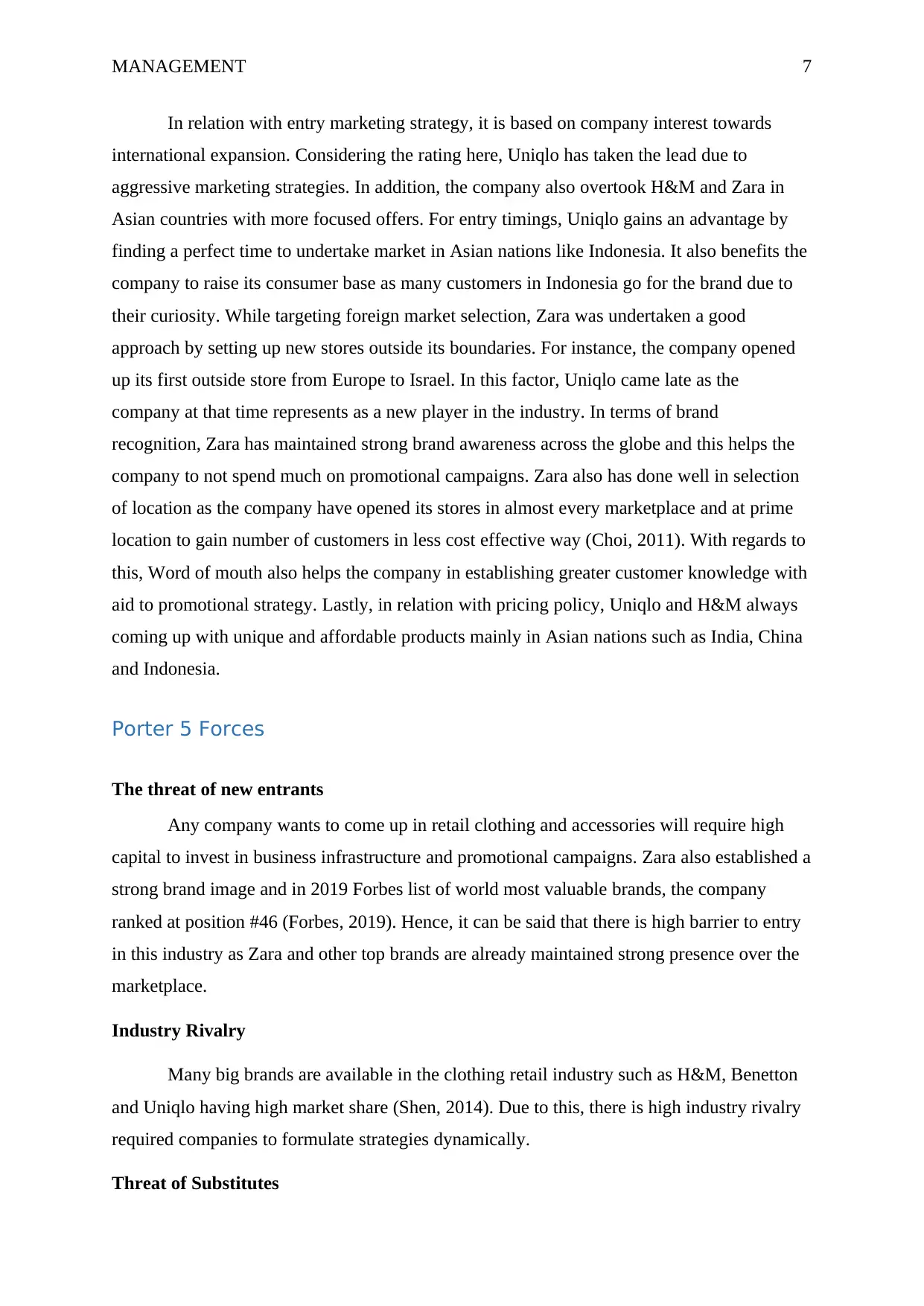
MANAGEMENT 7
In relation with entry marketing strategy, it is based on company interest towards
international expansion. Considering the rating here, Uniqlo has taken the lead due to
aggressive marketing strategies. In addition, the company also overtook H&M and Zara in
Asian countries with more focused offers. For entry timings, Uniqlo gains an advantage by
finding a perfect time to undertake market in Asian nations like Indonesia. It also benefits the
company to raise its consumer base as many customers in Indonesia go for the brand due to
their curiosity. While targeting foreign market selection, Zara was undertaken a good
approach by setting up new stores outside its boundaries. For instance, the company opened
up its first outside store from Europe to Israel. In this factor, Uniqlo came late as the
company at that time represents as a new player in the industry. In terms of brand
recognition, Zara has maintained strong brand awareness across the globe and this helps the
company to not spend much on promotional campaigns. Zara also has done well in selection
of location as the company have opened its stores in almost every marketplace and at prime
location to gain number of customers in less cost effective way (Choi, 2011). With regards to
this, Word of mouth also helps the company in establishing greater customer knowledge with
aid to promotional strategy. Lastly, in relation with pricing policy, Uniqlo and H&M always
coming up with unique and affordable products mainly in Asian nations such as India, China
and Indonesia.
Porter 5 Forces
The threat of new entrants
Any company wants to come up in retail clothing and accessories will require high
capital to invest in business infrastructure and promotional campaigns. Zara also established a
strong brand image and in 2019 Forbes list of world most valuable brands, the company
ranked at position #46 (Forbes, 2019). Hence, it can be said that there is high barrier to entry
in this industry as Zara and other top brands are already maintained strong presence over the
marketplace.
Industry Rivalry
Many big brands are available in the clothing retail industry such as H&M, Benetton
and Uniqlo having high market share (Shen, 2014). Due to this, there is high industry rivalry
required companies to formulate strategies dynamically.
Threat of Substitutes
In relation with entry marketing strategy, it is based on company interest towards
international expansion. Considering the rating here, Uniqlo has taken the lead due to
aggressive marketing strategies. In addition, the company also overtook H&M and Zara in
Asian countries with more focused offers. For entry timings, Uniqlo gains an advantage by
finding a perfect time to undertake market in Asian nations like Indonesia. It also benefits the
company to raise its consumer base as many customers in Indonesia go for the brand due to
their curiosity. While targeting foreign market selection, Zara was undertaken a good
approach by setting up new stores outside its boundaries. For instance, the company opened
up its first outside store from Europe to Israel. In this factor, Uniqlo came late as the
company at that time represents as a new player in the industry. In terms of brand
recognition, Zara has maintained strong brand awareness across the globe and this helps the
company to not spend much on promotional campaigns. Zara also has done well in selection
of location as the company have opened its stores in almost every marketplace and at prime
location to gain number of customers in less cost effective way (Choi, 2011). With regards to
this, Word of mouth also helps the company in establishing greater customer knowledge with
aid to promotional strategy. Lastly, in relation with pricing policy, Uniqlo and H&M always
coming up with unique and affordable products mainly in Asian nations such as India, China
and Indonesia.
Porter 5 Forces
The threat of new entrants
Any company wants to come up in retail clothing and accessories will require high
capital to invest in business infrastructure and promotional campaigns. Zara also established a
strong brand image and in 2019 Forbes list of world most valuable brands, the company
ranked at position #46 (Forbes, 2019). Hence, it can be said that there is high barrier to entry
in this industry as Zara and other top brands are already maintained strong presence over the
marketplace.
Industry Rivalry
Many big brands are available in the clothing retail industry such as H&M, Benetton
and Uniqlo having high market share (Shen, 2014). Due to this, there is high industry rivalry
required companies to formulate strategies dynamically.
Threat of Substitutes
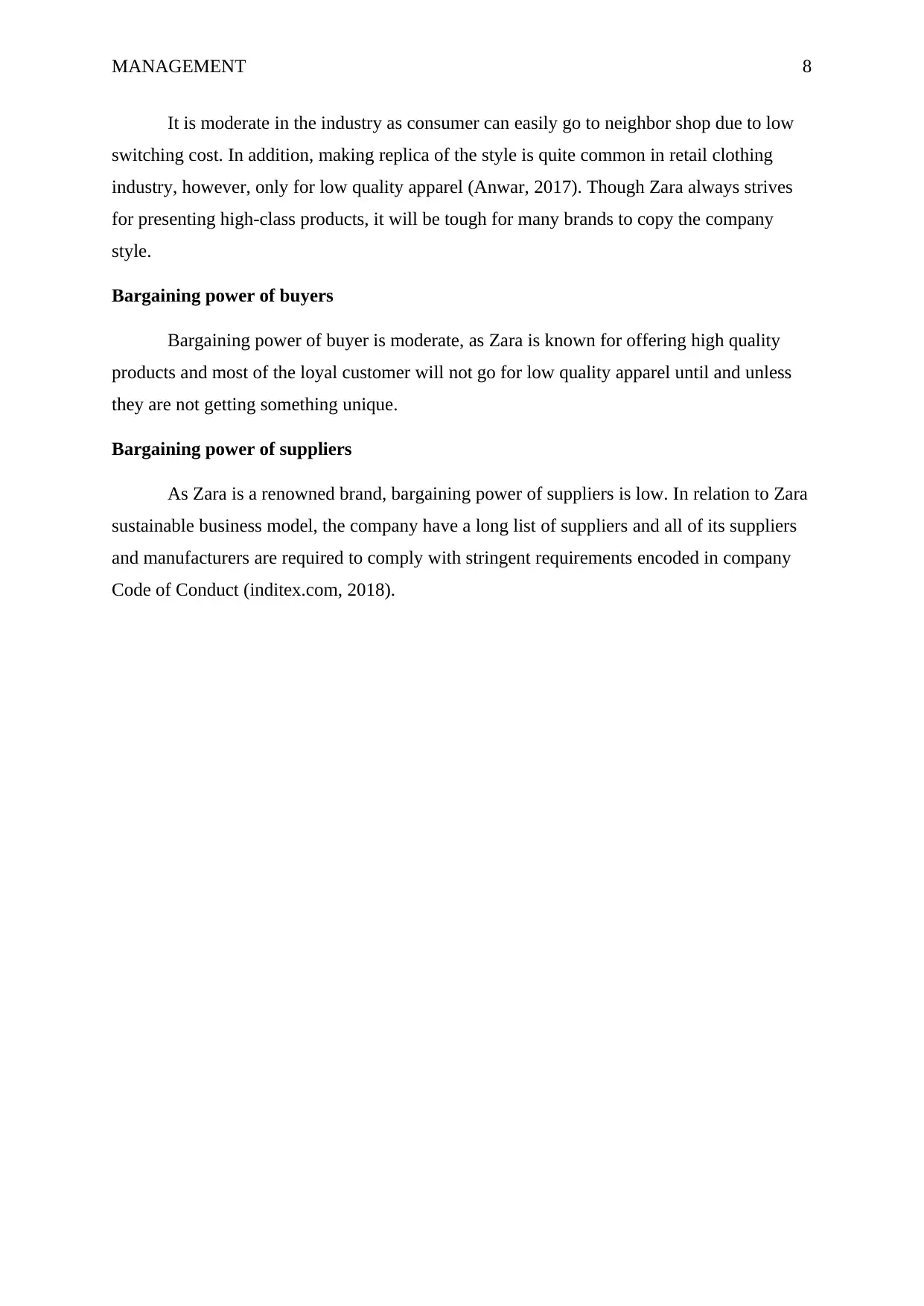
MANAGEMENT 8
It is moderate in the industry as consumer can easily go to neighbor shop due to low
switching cost. In addition, making replica of the style is quite common in retail clothing
industry, however, only for low quality apparel (Anwar, 2017). Though Zara always strives
for presenting high-class products, it will be tough for many brands to copy the company
style.
Bargaining power of buyers
Bargaining power of buyer is moderate, as Zara is known for offering high quality
products and most of the loyal customer will not go for low quality apparel until and unless
they are not getting something unique.
Bargaining power of suppliers
As Zara is a renowned brand, bargaining power of suppliers is low. In relation to Zara
sustainable business model, the company have a long list of suppliers and all of its suppliers
and manufacturers are required to comply with stringent requirements encoded in company
Code of Conduct (inditex.com, 2018).
It is moderate in the industry as consumer can easily go to neighbor shop due to low
switching cost. In addition, making replica of the style is quite common in retail clothing
industry, however, only for low quality apparel (Anwar, 2017). Though Zara always strives
for presenting high-class products, it will be tough for many brands to copy the company
style.
Bargaining power of buyers
Bargaining power of buyer is moderate, as Zara is known for offering high quality
products and most of the loyal customer will not go for low quality apparel until and unless
they are not getting something unique.
Bargaining power of suppliers
As Zara is a renowned brand, bargaining power of suppliers is low. In relation to Zara
sustainable business model, the company have a long list of suppliers and all of its suppliers
and manufacturers are required to comply with stringent requirements encoded in company
Code of Conduct (inditex.com, 2018).
⊘ This is a preview!⊘
Do you want full access?
Subscribe today to unlock all pages.

Trusted by 1+ million students worldwide
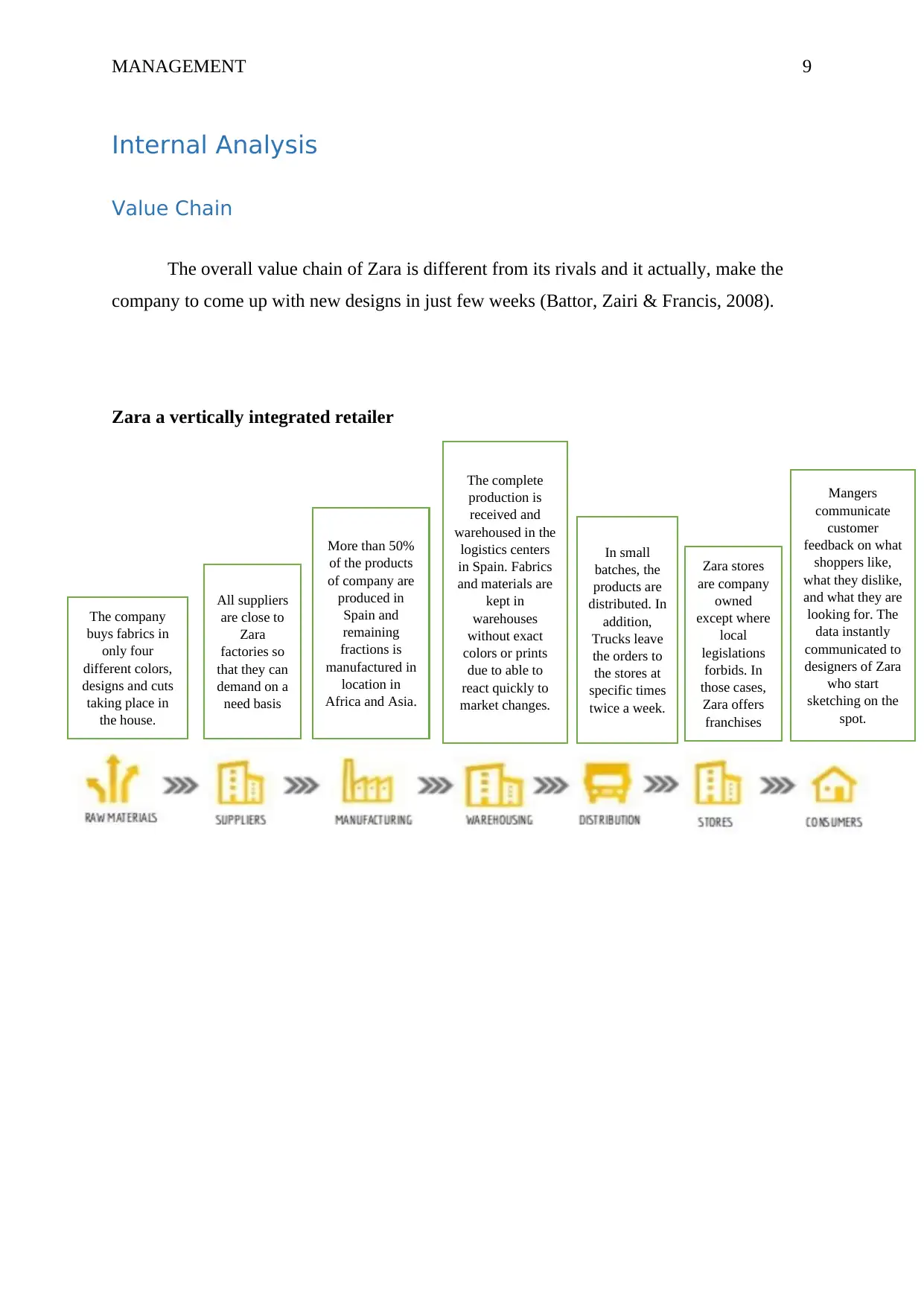
MANAGEMENT 9
Internal Analysis
Value Chain
The overall value chain of Zara is different from its rivals and it actually, make the
company to come up with new designs in just few weeks (Battor, Zairi & Francis, 2008).
Zara a vertically integrated retailer
The company
buys fabrics in
only four
different colors,
designs and cuts
taking place in
the house.
All suppliers
are close to
Zara
factories so
that they can
demand on a
need basis
More than 50%
of the products
of company are
produced in
Spain and
remaining
fractions is
manufactured in
location in
Africa and Asia.
The complete
production is
received and
warehoused in the
logistics centers
in Spain. Fabrics
and materials are
kept in
warehouses
without exact
colors or prints
due to able to
react quickly to
market changes.
In small
batches, the
products are
distributed. In
addition,
Trucks leave
the orders to
the stores at
specific times
twice a week.
Zara stores
are company
owned
except where
local
legislations
forbids. In
those cases,
Zara offers
franchises
Mangers
communicate
customer
feedback on what
shoppers like,
what they dislike,
and what they are
looking for. The
data instantly
communicated to
designers of Zara
who start
sketching on the
spot.
Internal Analysis
Value Chain
The overall value chain of Zara is different from its rivals and it actually, make the
company to come up with new designs in just few weeks (Battor, Zairi & Francis, 2008).
Zara a vertically integrated retailer
The company
buys fabrics in
only four
different colors,
designs and cuts
taking place in
the house.
All suppliers
are close to
Zara
factories so
that they can
demand on a
need basis
More than 50%
of the products
of company are
produced in
Spain and
remaining
fractions is
manufactured in
location in
Africa and Asia.
The complete
production is
received and
warehoused in the
logistics centers
in Spain. Fabrics
and materials are
kept in
warehouses
without exact
colors or prints
due to able to
react quickly to
market changes.
In small
batches, the
products are
distributed. In
addition,
Trucks leave
the orders to
the stores at
specific times
twice a week.
Zara stores
are company
owned
except where
local
legislations
forbids. In
those cases,
Zara offers
franchises
Mangers
communicate
customer
feedback on what
shoppers like,
what they dislike,
and what they are
looking for. The
data instantly
communicated to
designers of Zara
who start
sketching on the
spot.
Paraphrase This Document
Need a fresh take? Get an instant paraphrase of this document with our AI Paraphraser
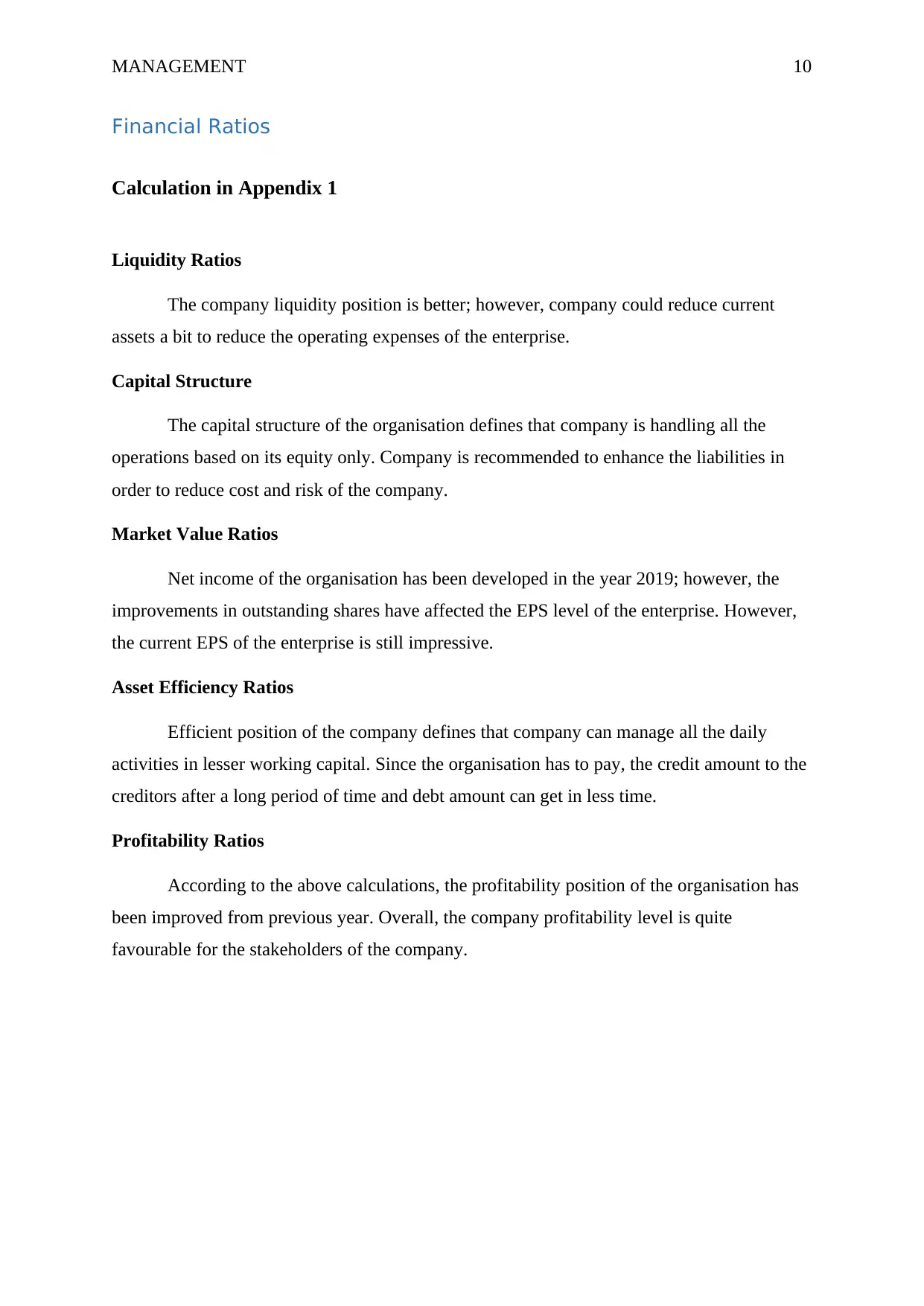
MANAGEMENT 10
Financial Ratios
Calculation in Appendix 1
Liquidity Ratios
The company liquidity position is better; however, company could reduce current
assets a bit to reduce the operating expenses of the enterprise.
Capital Structure
The capital structure of the organisation defines that company is handling all the
operations based on its equity only. Company is recommended to enhance the liabilities in
order to reduce cost and risk of the company.
Market Value Ratios
Net income of the organisation has been developed in the year 2019; however, the
improvements in outstanding shares have affected the EPS level of the enterprise. However,
the current EPS of the enterprise is still impressive.
Asset Efficiency Ratios
Efficient position of the company defines that company can manage all the daily
activities in lesser working capital. Since the organisation has to pay, the credit amount to the
creditors after a long period of time and debt amount can get in less time.
Profitability Ratios
According to the above calculations, the profitability position of the organisation has
been improved from previous year. Overall, the company profitability level is quite
favourable for the stakeholders of the company.
Financial Ratios
Calculation in Appendix 1
Liquidity Ratios
The company liquidity position is better; however, company could reduce current
assets a bit to reduce the operating expenses of the enterprise.
Capital Structure
The capital structure of the organisation defines that company is handling all the
operations based on its equity only. Company is recommended to enhance the liabilities in
order to reduce cost and risk of the company.
Market Value Ratios
Net income of the organisation has been developed in the year 2019; however, the
improvements in outstanding shares have affected the EPS level of the enterprise. However,
the current EPS of the enterprise is still impressive.
Asset Efficiency Ratios
Efficient position of the company defines that company can manage all the daily
activities in lesser working capital. Since the organisation has to pay, the credit amount to the
creditors after a long period of time and debt amount can get in less time.
Profitability Ratios
According to the above calculations, the profitability position of the organisation has
been improved from previous year. Overall, the company profitability level is quite
favourable for the stakeholders of the company.
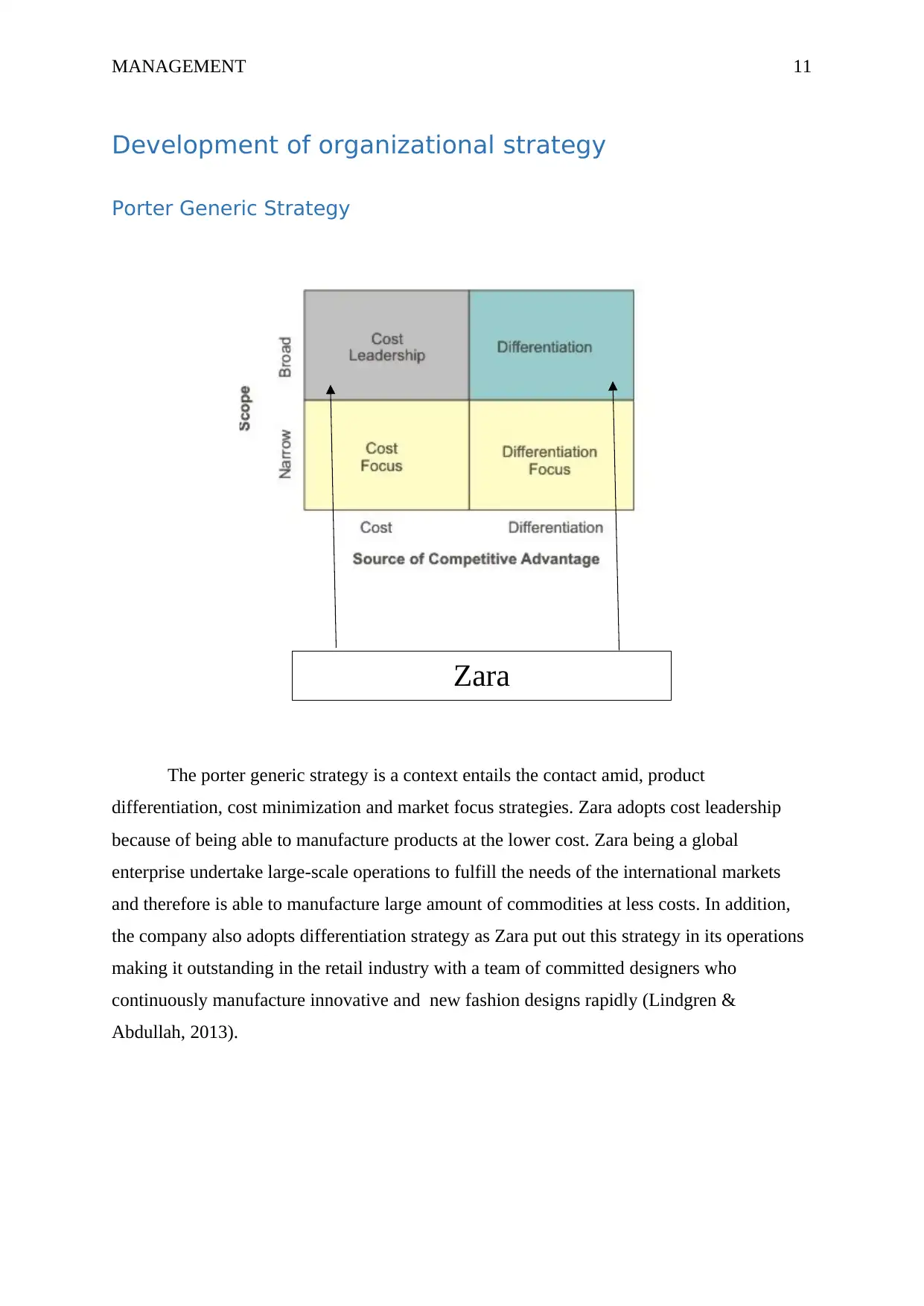
MANAGEMENT 11
Development of organizational strategy
Porter Generic Strategy
The porter generic strategy is a context entails the contact amid, product
differentiation, cost minimization and market focus strategies. Zara adopts cost leadership
because of being able to manufacture products at the lower cost. Zara being a global
enterprise undertake large-scale operations to fulfill the needs of the international markets
and therefore is able to manufacture large amount of commodities at less costs. In addition,
the company also adopts differentiation strategy as Zara put out this strategy in its operations
making it outstanding in the retail industry with a team of committed designers who
continuously manufacture innovative and new fashion designs rapidly (Lindgren &
Abdullah, 2013).
Zara
Development of organizational strategy
Porter Generic Strategy
The porter generic strategy is a context entails the contact amid, product
differentiation, cost minimization and market focus strategies. Zara adopts cost leadership
because of being able to manufacture products at the lower cost. Zara being a global
enterprise undertake large-scale operations to fulfill the needs of the international markets
and therefore is able to manufacture large amount of commodities at less costs. In addition,
the company also adopts differentiation strategy as Zara put out this strategy in its operations
making it outstanding in the retail industry with a team of committed designers who
continuously manufacture innovative and new fashion designs rapidly (Lindgren &
Abdullah, 2013).
Zara
⊘ This is a preview!⊘
Do you want full access?
Subscribe today to unlock all pages.

Trusted by 1+ million students worldwide
1 out of 20
Related Documents
Your All-in-One AI-Powered Toolkit for Academic Success.
+13062052269
info@desklib.com
Available 24*7 on WhatsApp / Email
![[object Object]](/_next/static/media/star-bottom.7253800d.svg)
Unlock your academic potential
Copyright © 2020–2025 A2Z Services. All Rights Reserved. Developed and managed by ZUCOL.



